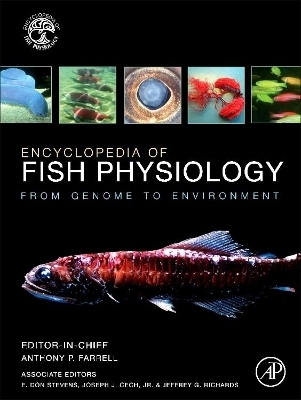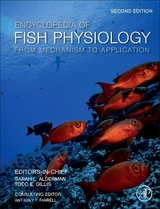
Encyclopedia of Fish Physiology
Academic Press Inc (Verlag)
978-0-12-374545-3 (ISBN)
- Titel erscheint in neuer Auflage
- Artikel merken
Fish form an extremely diverse group of vertebrates. At a conservative estimate at least 40% of the world's vertebrates are fish. On the one hand they are united by their adaptations to an aquatic environment and on the other they show a variety of adaptations to differing environmental conditions - often to extremes of temperature, salinity, oxygen level and water chemistry. They exhibit an array of behavioural and reproductive systems. Interesting in their own right, this suite of adaptive physiologies provides many model systems for both comparative vertebrate and human physiologists.This four volume encyclopedia covers the diversity of fish physiology in over 300 articles and provides entry level information for students and summary overviews for researchers alike.Broadly organised into four themes, articles cover Functional, Thematic, and Phylogenetic Physiology, and Fish Genomics.Functional articles address the traditional aspects of fish physiology that are common to all areas of vertebrate physiology including: Reproduction, Respiration, Neural (Sensory, Central, Effector), Endocrinology, Renal, Cardiovascular, Acid-base Balance, Osmoregulation, Ionoregulation, Digestion, Metabolism, Locomotion, and so on.Thematic Physiology articles are carefully selected and fewer in number. They provide a level of integration that goes beyond the coverage in the Functional Physiology topics and include discussions of Toxicology, Air-breathing, Migrations, Temperature, Endothermy, etc.Phylogenetic Physiology articles bring together information that bridges the physiology of certain groupings of fishes where the knowledge base has a sufficient depth and breadth and include articles on Ancient Fishes, Tunas, Sharks, etc.Genomics articles describe the underlying genetic component of fish physiology and high light their suitability and use as model organisms for the study of disease, stress and physiological adaptations and reactions to external conditions.
Dr. Tony Farrell is a Professor Emeritus in the Department of Zoology & Faculty of Land and Food Systems at the University of British Columbia and a Fellow of the Royal Society of Canada. His research had provided an understanding of fish cardiorespiratory systems and has applied this knowledge to salmon migratory passage, fish stress handling and their recovery, sustainable aquaculture and aquatic toxicology. He has over 490 research publications in peer-reviewed scientific journals and an h-factor of 92. He has co-edited of 30 volumes of the Fish Physiology series, as well as an award-winning Encyclopedia of Fish Physiology. As part of his application of physiology to aquaculture, he has studied the sub-lethal impacts of sea lice and piscine orthoreovirus on the physiology of juvenile salmon. Dr. Farrell has received multiple awards, including the Fry Medal, which is the highest honour to a scientist from the Canadian Society of Zoologists, the Beverton Medal, which is the highest honour to a scientist from the Fisheries Society of the British Isles, the Award of Excellence, which is the highest honour of the American Fisheries Society and the Murray A. Newman Awards both for Research and for Conservation from the Vancouver Marine Sciences Centre. He is a former President of the Society of Experimental Biologists and a former Editor-in-Chief for the Journal of Fish Biology. He served as a member of the Minister’s Aquaculture Advisory Committee on Finfish Aquaculture for British Columbia and was a member of the Federal Independent Expert Panel on Aquaculture Science.
Volume 1 THE SENSES, SUPPORTING TISSUES, REPRODUCTION, AND BEHAVIOR
Sensing the Environment:
Brain and Nervous System
Vision
Smell, Taste, and Chemical Sensing
Hearing and Lateral Line
Detection and Generation of Electric Signals
Muscles, Skeleton, Skin, and Movement:
The Skeleton
The Muscles
The Skin
Buoyancy, Locomotion, and Movement in Fishes
Reproduction:
The Reproductive Organs and Processes
Behavior and Physiology:
Social and Reproductive Behaviors
Sensory Systems, Perception, and Learning
Behavioral Responses to the Environment
Volume 2: GAS EXCHANGE, INTERNAL HOMEOSTATIS, AND FOOD UPTAKE
Gas Exchange:
Ventilation and Animal Respiration
Control of Respiration
Transport and Exchange of Respiratory Gases in the Blood
Tissue Respiration
Tissue Respiration:
Blood
Design and Physiology of the Heart
Design and Physiology of Arteries and Veins
Design and Physiology of Capillaries and Secondary Circulation
Integrated Control and Response of the Circulatory System
The Gut:
Gut Anatomy and Morphology
Integrated Function and Control of the Gut
Osmotic, Ionic and Nitrogenous-Waste Balance
Role of the Gills
Role of the Kidneys
Role of the Gut
Nitrogenous-Waste Balance
Hormonal Controls:
The Pituitary
Hormonal Control of Metabolism and Ionic Regulation
Hormonal Control of Reproduction and Growth
Hormonal Responses to Stress
Volume 3: ENERGETICS, INTERACTIONS WITH THE ENVIRONMENT, LIFESTYLES, AND APPLICATIONS
ENERGETICS:
Food Acquisition and Digestion
Energy Utilization in Growth
Swimming and Other Activities
Energetic Models
Responses and Adaptations to the Environment:
Temperature
Hypoxia
Physiological Specializations of Different Fish Groups:
Hagfishes and Lamprey
Sturgeon
Bony Fishes
Air-Breathing Fishes
Pelagic Fishes
Fish Migrations
Deep-Sea Fishes
Intertidal Fishes
Applied Aspects of Fish Physiology:
Cellular, Molecular, Genomics, and Biomedical Approaches
Toxicology
Aquaculture
| Mitarbeit |
Chef-Herausgeber: Anthony Farrell |
|---|---|
| Verlagsort | San Diego |
| Sprache | englisch |
| Maße | 210 x 279 mm |
| Gewicht | 7430 g |
| Themenwelt | Naturwissenschaften ► Biologie ► Ökologie / Naturschutz |
| Naturwissenschaften ► Biologie ► Zoologie | |
| Wirtschaft ► Volkswirtschaftslehre ► Mikroökonomie | |
| ISBN-10 | 0-12-374545-4 / 0123745454 |
| ISBN-13 | 978-0-12-374545-3 / 9780123745453 |
| Zustand | Neuware |
| Haben Sie eine Frage zum Produkt? |
aus dem Bereich



